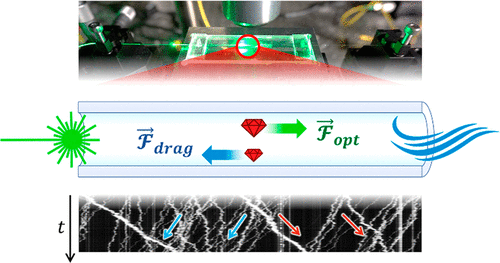当前位置:
X-MOL 学术
›
ACS Appl. Nano Mater.
›
论文详情
Our official English website, www.x-mol.net, welcomes your
feedback! (Note: you will need to create a separate account there.)
Optical Transport and Sorting of Fluorescent Nanodiamonds inside a Tapered Glass Capillary: Optical Sorting of Nanomaterials at the Femtonewton Scale
ACS Applied Nano Materials ( IF 5.3 ) Pub Date : 2020-03-18 , DOI: 10.1021/acsanm.0c00274 Christophe Pin 1 , Ryohei Otsuka 1 , Keiji Sasaki 1
ACS Applied Nano Materials ( IF 5.3 ) Pub Date : 2020-03-18 , DOI: 10.1021/acsanm.0c00274 Christophe Pin 1 , Ryohei Otsuka 1 , Keiji Sasaki 1
Affiliation

|
Nanoparticles from biological, environmental, or industrial sources always show some dispersion in size, shape, composition, and related physical or chemical properties. Sorting nanoparticles according to well-defined criteria is often a crucial but challenging task. While optical forces may be used to target some specific properties such as the size, shape, absorption wavelength, and chirality of nanoparticles, optical sorting techniques usually suffer from the fast diffusion of nanoparticles in comparison to the relative weakness of the optical forces acting on dielectric nanomaterials in liquid dispersion. To achieve high-efficiency optical sorting of an ensemble of nanoparticles in colloidal dispersion, all the nanoparticles to be sorted should be gathered and kept in the light path for a sufficient time. For this purpose, we investigate the use of tapered glass capillaries as optofluidic platforms for optical manipulation and optical sorting applications. While the transparent pipe-like structure of the capillary serves as an optical waveguide that focuses the laser light over a few-millimeter-long distance, the inner part of the capillary forms a microfluidic channel that is filled with a water dispersion of 100 nm fluorescent nanodiamonds (NDs). We first demonstrate power-dependent optical transport of NDs inside few-micrometer-large capillaries. It is observed that NDs located inside the waist of the tapered capillary can be optically propelled at velocities reaching few tens of micrometer per second. We then show how a liquid flow inside the channel enables efficient, size-dependent sorting of a large ensemble of NDs. An analytical model is used to evaluate the influence of the NDs’ size on the optical and hydrodynamic drag forces acting on the nanoparticles, both being in the femtonewton range.
中文翻译:

锥形玻璃毛细管内部的荧光纳米金刚石的光学传输和分选:Femtonewton规模的纳米材料的光学分选。
来自生物,环境或工业来源的纳米颗粒在尺寸,形状,组成以及相关的物理或化学特性方面始终显示出一定的分散性。根据明确的标准对纳米颗粒进行分选通常是一项至关重要但具有挑战性的任务。尽管可以使用光学力来靶向某些特定属性,例如纳米粒子的大小,形状,吸收波长和手性,但是与光学力作用在电介质上的相对弱点相比,光学分选技术通常会遭受纳米粒子的快速扩散分散液中的纳米材料。为了实现胶体分散体中纳米颗粒集合的高效光学分选,应收集所有要分选的纳米颗粒,并在光路中放置足够的时间。以此目的,我们研究了将锥形玻璃毛细管用作光学操纵和光学分类应用的光流体平台。毛细管的透明管状结构用作将激光聚焦在几毫米长距离上的光波导,而毛细管的内部形成微流体通道,该通道中充满了100 nm荧光水纳米金刚石(NDs)。我们首先展示了几微米大的毛细管内ND的功率依赖性光传输。可以观察到,位于锥形毛细管腰部内部的ND可以以每秒几十微米的速度被光学推动。然后,我们展示了通道内的液体流如何实现对大尺寸ND的高效,大小依赖的分选。
更新日期:2020-03-18
中文翻译:

锥形玻璃毛细管内部的荧光纳米金刚石的光学传输和分选:Femtonewton规模的纳米材料的光学分选。
来自生物,环境或工业来源的纳米颗粒在尺寸,形状,组成以及相关的物理或化学特性方面始终显示出一定的分散性。根据明确的标准对纳米颗粒进行分选通常是一项至关重要但具有挑战性的任务。尽管可以使用光学力来靶向某些特定属性,例如纳米粒子的大小,形状,吸收波长和手性,但是与光学力作用在电介质上的相对弱点相比,光学分选技术通常会遭受纳米粒子的快速扩散分散液中的纳米材料。为了实现胶体分散体中纳米颗粒集合的高效光学分选,应收集所有要分选的纳米颗粒,并在光路中放置足够的时间。以此目的,我们研究了将锥形玻璃毛细管用作光学操纵和光学分类应用的光流体平台。毛细管的透明管状结构用作将激光聚焦在几毫米长距离上的光波导,而毛细管的内部形成微流体通道,该通道中充满了100 nm荧光水纳米金刚石(NDs)。我们首先展示了几微米大的毛细管内ND的功率依赖性光传输。可以观察到,位于锥形毛细管腰部内部的ND可以以每秒几十微米的速度被光学推动。然后,我们展示了通道内的液体流如何实现对大尺寸ND的高效,大小依赖的分选。










































 京公网安备 11010802027423号
京公网安备 11010802027423号